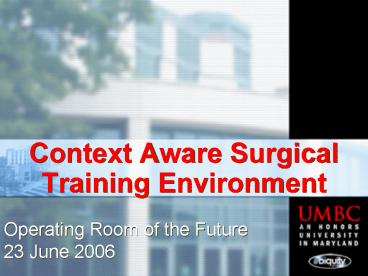Context Aware Surgical Training Environment - PowerPoint PPT Presentation
Title:
Context Aware Surgical Training Environment
Description:
The activities and events going on and the roles people are playing in them ... Events. Events. Simulations and Results. The Human Patient Simulator (HPS) from METI ... – PowerPoint PPT presentation
Number of Views:58
Avg rating:3.0/5.0
Title: Context Aware Surgical Training Environment
1
Context Aware SurgicalTraining Environment
- Operating Room of the Future 23 June 2006
2
Vision
- ORs and surgical training centers will be
pervasive computing environments - Devices, sensors, tags, trainers, PDAs, monitors
will discover one another and interoperate - Components will require access to a context model
to manage resources effectively - The context model includes relevant information
on people, roles, activities, events, workflow,
devices, - Intelligent components will be able to recognize
events and activities - Even in the presence of noisy or incomplete data
3
SimCenter Context Model
- The people, devices, environmental factors,
information resources, - The activities and events going on and the roles
people are playing in them - The anticipated schedules, workflow models,
training plans, - Profiles of the training resources
capabilities, complexity, ... - Profiles of the trainees, their background,
training goals, training history, training plans - Privacy and information sharing constraints and
policies
4
SimCenter Interoperability
- Interoperability means that devices and systems
can share and use models, data and services as
needed - Training resources can be intelligently matched
to the training needs and profiles of trainees - Constructing and monitoring customized training
experiences, enabled by data and model
interoperability - Capability of end-to-end simulation fly throughs
5
ORs will be data rich
Drugs
RFID
RFID
CAST
Tools
RFID
Patient Monitors
Staff
- ORs will be awash in low-level data, much of it
noisy or incomplete - Challenges include coping with the noise and
interpreting the low-level data to recognize
high-level events and activities
6
Streaming Database Engines
- TelegraphCQ Data Stream Management System from UC
Berkeley
- Data is stored/indexed in system
- Queries applied to stored data as they stream
through
- Queries stored/indexed in system
- Data applied to stored queries as they stream
through
7
Example Streams Queries
- Data Sources (DS)
- Continually send data to streams
- PUSH or PULL sources
- Stream
- create stream traffic.incidents (
- incidentID integer,
- city varchar(100),
- street varchar(100),
- description varchar(1000),
- tcqtime timestamp TIMESTAMPCOLUMN
- ) type archived
- 2207, Dublin, JWO HACIENDA DR, Traffic Hazard -
Debris/Objects, Wed Jul 16 183700 PDT 2003 - Continuous queries must be specified over a time
window - Select count() from mer.rfid range by 30
seconds slide by 10 seconds group by tag_id - Window is relative to the most recently arrived
tuple.
8
System Architecture
Trend Analyzer
Rule Base
9
(No Transcript)
10
Simulations and Results
- The Human Patient Simulator (HPS) from METI
- Designed to react like a human
- Used for training resident doctors
- Responds to medical treatment
- Physiological data sets from HPS
11
Scenario and Patient Profile
- HPS can run patient profiles
- Data logs from simulations used to evaluate the
system - Significant events for a blunt trauma multiple
injuries profile include hypovolemia, tension
pneumothorax, decompression and fluid infusions - Provides data for Medical Encounter Record
- Ran 30 simulations on 7 profiles measuring false
positives negatives and latency in detecting
events
Patient Profile
12
(No Transcript)
13
Status and Plans
- Were building on work done for Trauma Pod
- Preliminary work has produced a scalable
architecture based on TelegraphCQ, the Jess rule
based reasoning engine and relational databases - Fall 2006
- Install equipment in SimCenter in Fall 2006
- Investigate use of LiveDatas system for output
- Develop ontologies in RDF/OWL to support semantic
interoperability - Spring 2007
- Develop and implement scenarios for proof of
concept and evaluation
14
Key Enablers
- Semantic interoperability
- Develop and use standard ontologies and data
models to maximize information sharing - Use evolving standards (XML, RDF, )
- Greater context awareness and intelligence
- The whole is more than the sum of its parts --
drawing inferences, integrating across all
entities, and recognizing patterns - A service oriented architecture
- Distributed programs and resources share common
interface standards and publish their APIs
15
http//ebiquity.umbc.edu/































